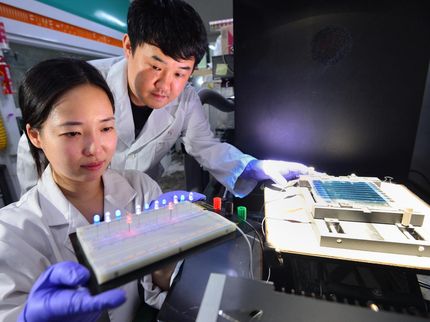Cleaner and greener cities with integrated transparent solar cells
High power conversion of new solar cells that are thin, flexible, and transparent makes them ideal for a wealth of new applications
Imagine buildings in which the windows allow the sun's light to enter, and at the same time capture the energy from the sun needed to meet all their energy needs. In this seemingly futuristic scenario, the windows become productive solar cells that help us decrease our reliance on fossil fuels and advance towards a greener and cleaner environment. In a recent study carried out at ICFO, researchers have fabricated an optimal organic solar cell with a high level of transparency and a high power conversion efficiency, a promising step forward towards affordable, clean, more widely utilized and urban integrated renewable energies. The results of this study have been published in Nature photonics.
Today's commercial solar panels are, for the most part, composed of wafer-based crystalline silicon solar cells which are quite efficient in converting solar radiation into electrical power (approximately 15% conversion efficiency), but with several important obstacles standing in the way of maximum exploitation. To begin, they must be precisely oriented to receive direct sunlight and even then are limited in their ability to absorb diffused light. In addition, they are heavy, opaque, and take up a great deal of space.
Organic solar cell technology has been around for about thirty years, however nowadays it is starting to attract substantial interest due to its low production cost. While organic cells have not yet reached the efficiency values of silicon based cells, these Organic Photovoltaic (OPV) cells have proven to be lighter in weight, more flexible (they are capable of adapting to curved surfaces), and even more sensitive to low light levels as well as indirect sun light, making them one of the most appealing photovoltaic technologies for many everyday applications. Among such advantages, a property that makes them even more interesting is their potential to be implemented as a semi-transparent device.
However, OPVs, like any other photovoltaic technology achieves its maximum light to electricity conversion efficiency with opaque devices. To turn such cells into transparent ones, the back metal electrode must be thinned down to just a few nanometers, drastically reducing the device's capacity to collect sunlight. ICFO researchers have been able to implement a semi-transparent cell incorporating a photonic crystal and reach a cell performance almost as good as its opaque counterpart. By adding such extra photonic crystal to the cell, ICFO's scientists were able to increase the amount of infrared and ultraviolet light absorbed by the cell, reaching a 5.6% efficiency while preserving a transparency almost indistinguishable from normal glass. The results in efficiency and transparency make these cells an extremely competitive product for Building-Integrated Photovoltaic (BIPV) technologies. To reach the adequate architectural look, the color of the cells may be tuned by simply changing the layer configuration of the photonic crystal.
Jordi Martorell, UPC Professor at ICFO and leader of the study, explains that "applications for this type of technology in BIPV are just a few steps away, but the technology has not reached its saturation point yet. ICFO's discovery opens the path for innovation to other industrial applications of transparent photovoltaics. In the midterm we expect to reach the extremely high transparencies and efficiencies needed to power up devices such as displays, tablets, smart phones, etc…"
The future looks promising for these devices. A recently approved European project entitled SOLPROCEL will allow a consortium of top European researchers and industries led by ICFO to boost the study of the capabilities of these cells, improving their stability and lifetimes as well as obtaining the material needed to substantially raise their efficiency.
Original publication
Other news from the department science

Get the chemical industry in your inbox
By submitting this form you agree that LUMITOS AG will send you the newsletter(s) selected above by email. Your data will not be passed on to third parties. Your data will be stored and processed in accordance with our data protection regulations. LUMITOS may contact you by email for the purpose of advertising or market and opinion surveys. You can revoke your consent at any time without giving reasons to LUMITOS AG, Ernst-Augustin-Str. 2, 12489 Berlin, Germany or by e-mail at revoke@lumitos.com with effect for the future. In addition, each email contains a link to unsubscribe from the corresponding newsletter.



























































